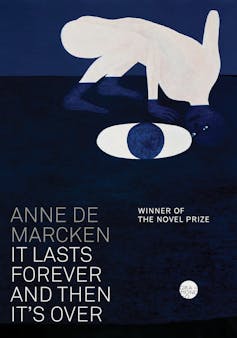What superseded literary postmodernism? Many contenders have been proposed: the new sincerity, metamodernism, even late postmodernism. But none of these terms have persisted.
The novel in English may now be dominated by autofiction, but autofiction arguably extends key aspects of postmodernism: it critiques universalism and emphasises the self-reflexively performative nature of identity.
In a recent reflection on Fredric Jameson’s seminal essay collection The Cultural Turn, McKenzie Wark noted this persistence of postmodern aesthetics:
there is now even retro-pomo, a kind of meta-retro, or meta-pomo, a return to the return to the return.
The two winners of the second Novel Prize – Jonathan Buckley’s Tell and Anne de Marcken’s It Lasts Forever and Then It’s Over – could not be more different in their substance and methods, but both seem part of this postmodern revival. They share an essentially postmodern disposition: both foreground the relational nature of truth; both inhabit popular genres for highbrow ends.
Review: Tell – Jonathan Buckley (Giramondo) & It Lasts Forever and Then It’s Over – Anne de Marcken (Giramondo)
The Novel Prize has quickly established itself as a major award in Anglophone literary culture. The biennial prize is run by three excellent publishers: Giramondo in Australia, New Directions in North America, and Fitzcarraldo Editions in the UK and Ireland. Winning manuscripts are published simultaneously by all three.
The inaugural winner, Jessica Au’s Cold Enough for Snow (2022), was a masterful work and one of my favourite Australian novels of the past few years. Though it nominally follows a mother and daughter travelling in Japan, it exists in a liminal space that feels simultaneously realist and surreal, exploring territory between traditional and experimental novelistic forms.
Given that all three publishers behind the Novel Prize are known for their complex and innovative fiction, Cold Enough for Snow was an ideal first winner: an exceptional novel with experimental qualities, but one that could still appeal to a broad audience.
Read more: The responsibilities of being: Jessica Au's precise, poetic meditation on mothers and daughters
Do tell
The two fascinating novels that have won the most recent Novel Prize are not particularly difficult, but their relationship to established traditions of experimental literature is clear.

Buckley’s Tell might be thought of as a disassembled murder mystery. The novel concerns the disappearance of a wealthy self-made entrepreneur named Curtis Doyle. His story is told by the gardener at his estate in Scotland. The novel takes the form of a typed-up audio transcript, a perception reinforced by having the narrative interrupted by the placeholder “[inaudible]”.
The notion of a fictional work as a record of a spoken text is as old as literature itself. The opening line of Homer’s Odyssey – “Tell me, O Muse, of the man of many devices…” – seems particularly resonant for this novel.
But Tell also resembles works like Gilbert Sorrentino’s Odd Number (1985), a novel that investigates a suspicious death by rendering the verbatim interrogations of three persons of interest. More recently, J.M. Coetzee’s fictionalised biography Summertime (2009), records the recollections of five people who knew him – Coetzee, in the fictive world of the novel, having recently died.
Buckley’s novel presents the thoughts of only one character. He attempts to make the unnamed narrator’s voice as realistic as possible, which means she often speaks in clichés:
A mid-range place, like the one where Curtis was working. Not designer stuff but not rubbish either. Anyway, the boss had bitten off more than he could chew and he needed cash in a hurry, so Curtis made him an offer. Not super-generous but better than bankruptcy, and beggars can’t be choosers. Somehow he got a loan to cover it. He could always talk the talk.
The playfulness of the final cliché (“talk the talk”) is obvious in a novel entitled Tell, but it is also hard not read this as a wilful and provocative violation of certain middlebrow and institutional literary norms. This is a novel that – against the advice of undergraduate creative-writing instructors across the world – is going to “tell” rather than “show”.
Tell is also full of characters (about 20 over its 190 pages), who, as in real-life, often have bland names. They are rarely and only partially described. The intentional result is that they blur together, rather than appearing as the rounded and complex characters associated with realist fiction. I quickly realised I was going to have to keep a list of who was whom, which I jotted down perfunctorily on the inside back cover.
But there is more going on in the background than might initially be obvious. Tell seems to end with an anticlimax that, taken at face value, could comprise a revision of the mystery genre. Instead of offering the resolution of a traditional whodunnit, Tell’s conclusion raises even larger questions.
The reader is not even sure what kind of person Curtis was. In a way, he has always been absent from the narrative. We learn, in the opening pages, that he had suffered a massive head trauma that changed his personality and caused other lingering effects, leading the narrator to speak of two distinct Curtises (before and after the accident).
The novel is also very much a dramatic monologue. In keeping with that tradition, there is a lingering sense that information is being withheld or controlled by our narrator (as in, for example, Robert Browning’s poem My Last Duchess). Here the title invokes the sense of a “tell” in poker. The narrator frequently reflects back on the process of storytelling in ways that undermine her authority: “With each retelling, every piece of the story had become more certain.”
The language of Tell may not be difficult, but the narrator’s evasions produce a sense of depth. There is plenty of implied (or simply buried) meaning in the relationships between characters to keep readers guessing. The narrator’s obsessive cataloguing of Curtis’ life and relationships seems wholly explicable as an effect of their class differences, yet it is also potentially malevolent. This literally puzzling novel will reward rereadings.
I have to admit that I was not previously aware of Buckley’s work, but Tell is his tenth novel. It is fantastic to see the Novel Prize bringing the work of established writers to greater international prominence.

Read more: Bad art friends – Jen Craig may be the best Australian writer you've never heard of
Zombie commune
Anne De Marcken’s It Lasts Forever and Then It’s Over takes on the great American zombie novel.
It can seem as if there are more inversions of zombie narratives than there are straightforward ones: Richard Matheson’s I Am Legend (1954) was turning the genre on its head well before we got Pride and Prejudice and Zombies (2009) and zombie rom-coms like Warm Bodies (2010).

It Lasts Forever depicts a post-apocalypse that feels simultaneously sublime and absurd. The opening gag works because the zombies are still essentially human in character: the narrator discovers her arm has fallen off, so she tries to reattach it in entirely practical ways with the help of a friend.
She lives in a sort of commune with other zombies, who engage in new-agey religious rituals to ward off hunger, and she ruminates on the Téa Leone television vehicle, Madame Secretary (2014-19). So far, so postmodern. The novel also signals its precursors through a series of epigraphs from Judith Butler, Susan Howe, Italo Calvino, Charles Simic and Hélène Cixous.
While funny, the zanier moments are not the strongest part of this 120-page novel. De Marcken is also capable of switching into surprisingly beautiful and surreal descriptions – for example, when the zombies, who do not need to breathe, go “wading”, which involves wandering around the bottom of the ocean.
Much of the novel is written in a fragment-heavy style that recalls post-Raymond Carver minimalism:
Exit 74. West because west is the direction of leaving behind. West because west is the last resort. I go west because west is where I remember you.
This style is effective and economical, but De Marcken is also capable of gnarled and dense descriptive language that draws on different traditions:
Up ahead the road doglegs sharply south and then west again, and just the way that an eddy at the bend in a river traps leaves and dead fish and snakes and trash, at this bend in the road there is a blue-tarped gyre of trailers, Blue Bird school busses, reefers and boxcars, algae-streaked motorhomes and mildewed park models all rafter together and piled in between with rusted frames and mossy shells of cars and trucks.
The rambling nature of this gorgeous long sentence formally mimics its own central metaphor: it slowly collects the detritus of post-apocalyptic civilisation, just like the bending river traps waste. You can see the influence of writers like Dennis Johnson, Marilynne Robinson and even Cormac McCarthy in the lengthy clauses, the nouns that have become verbs (“doglegs”, “rafter”), and the unexpected convergence of archaic and modern language (“a blue-tarped gyre of trailers”).
Parts of the second half of the novel might be in dialogue with McCarthy’s The Road (2006). One section appears to invert perhaps the most infamous scene from that novel, depicting a mother-figure who is slowly feeding herself to a zombie child.
The novel concludes with a brilliant series of Beckettian set pieces – think Happy Days – that vacillate between body horror and physical comedy. These sections are absolutely its high point.
Like Tell, It Lasts Forever is not a novel that innovates linguistically, but it is deeply unusual. It is hard to get purchase on because of the way it moves from the absurd to the disturbing and grotesque, incorporating finely observed natural details and even earnest expressions of lost love. It is a testament to the novel’s oddity that the protagonist’s decision, early in the novel, to place the dead body of crow inside her empty chest cavity seems wholly in keeping with the narrative.

Read more: Homemade and cosmopolitan, the idiosyncratic writing of Gerald Murnane continues to attract devotees
The memory of a memory
After reading Tell and It Lasts Forever, I thought of the music-reviewer turned experimental novelist David Keenan’s famous definition of what he called “hypnagogic pop”: music that was “refracted through the memory of a memory”.
Like that music, these novels present an ambiguous nostalgia for a postmodern experimentalism whose meaning remains unclear. Are they pushing forward new and uniquely contemporary literary approaches? Is that even a thing still worth doing, or simply a hangover from a long-dead modernism?
Or are these hypnagogic novels, intentionally repurposing older experimental techniques in slightly different ways that reflect a broader sense of exhaustion and inertia (which, in the case of De Marcken’s novel, is literally post-apocalyptic)?
Or are they something else altogether? Aside from a few specific details, they feel like they could have been written at any point in the past 40 years
This ambiguity is the source of their power. Whether or not these novels are “new”, they are truly strange. I am grateful that in the post-apocalyptic, post-Amazon world of 2024 we still have publishers willing to support books like these. More weird books, please!

